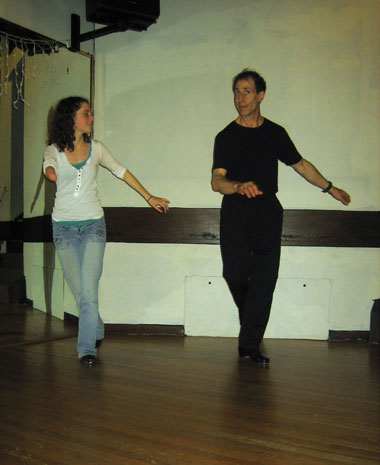Sam Weber
American rhythm tap dance
 American rhythm tap dance developed concurrently with jazz music from the middle of the 19th century. As a jazz art form, it is part of the African American tradition of music and dance, which stresses continual improvisation and propulsive rhythms. In its infancy, there was a lively exchange of steps and rhythms between Irish immigrants and newly freed African American slaves. Consequently, tap’s traditional vocabulary draws heavily upon the movements of Irish step dancing, which formed its technical base, and the syncopation of African music, which has formed the basis of jazz itself. The development of inexpensive metal taps, which could be attached to a pair of ordinary shoes, enabled the technique to become available to everyone, and tap became a mainstay of minstrel shows, Vaudeville, Broadway, and Hollywood films. It remained most true to its original character as an improvisational jazz art through the big bands and jazz clubs, which usually included tap dancers. And, like jazz music itself, tap continues to incorporate within itself diverse dance styles and rhythms from other cultural and musical traditions. Modern tap draws on classical and modern dance, Flamenco, Samba, Calypso, Rumba, Reggae, dance and music and Eastern Europe and Asia, hip-hop, and much more.
American rhythm tap dance developed concurrently with jazz music from the middle of the 19th century. As a jazz art form, it is part of the African American tradition of music and dance, which stresses continual improvisation and propulsive rhythms. In its infancy, there was a lively exchange of steps and rhythms between Irish immigrants and newly freed African American slaves. Consequently, tap’s traditional vocabulary draws heavily upon the movements of Irish step dancing, which formed its technical base, and the syncopation of African music, which has formed the basis of jazz itself. The development of inexpensive metal taps, which could be attached to a pair of ordinary shoes, enabled the technique to become available to everyone, and tap became a mainstay of minstrel shows, Vaudeville, Broadway, and Hollywood films. It remained most true to its original character as an improvisational jazz art through the big bands and jazz clubs, which usually included tap dancers. And, like jazz music itself, tap continues to incorporate within itself diverse dance styles and rhythms from other cultural and musical traditions. Modern tap draws on classical and modern dance, Flamenco, Samba, Calypso, Rumba, Reggae, dance and music and Eastern Europe and Asia, hip-hop, and much more.
Sam Weber bagan his training in American rhythm tap dance at the age of 4 in Washington, D.C., with Fred Nathan, an ex-Vaudeville performer. Sam studied with him until his family moved to the Bay Area when he was 10, at which time he began to study with Stan Kahn, who Sam considers his greatest influence. Sam has also learned from and performed with some of tap’s greatest masters, including Charles “Honi” Coles, Eddie Brown, Steve Condos, Jimmy Slyde, and Gregory Hines.
In 2008, Sam was a master artist in ACTA’s Apprenticeship Program, with apprentice Tal Oppenheimer. Their apprenticeship focused on honing skills including working in and alternating between time signatures, improving the sound and form of the dancing, improvisation, and studying new and historic choreographies.
